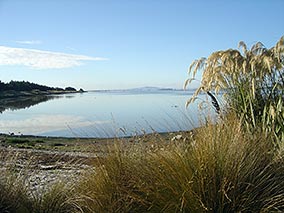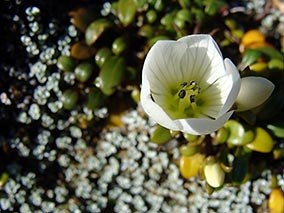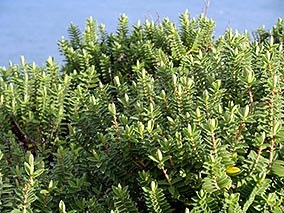The coast is the interface between land and sea and it takes a special type of plant to be able to grow there. Each plant that lives on the coast has found a way to adapt to exposure to strong winds and sea spray. Some are even able to live on sand dunes despite dry and windy conditions. Coastal plants have an amazing ability to survive and flourish in the most adverse conditions. Find out more about coastal plants in Southland.
Types of coastal habitat
Southland has a diverse range of coastal habitat and associated communities. Coastal habitats in Southland include:
- Coastlines of Fiordland and Stewart Island.
- Sand dunes and dune slacks.
- Gravel beaches.
- Estuaries and harbours.
- Coastal wetlands and lagoons.
Specialised coastal plant communities in Southland include:
- Coastal turfs.
- Coastal tussockland.
- Coastal shrublands.
- Coastal forest.
Coastal habitats in Southland
The Southland Region contains over 3,000 kilometres of coastline. Approximately 63% of that (1,892 km) is located in Fiordland and a further 26% (781 km) is the coastline of Stewart Island.
Coastlines of Fiordland and Stewart Island
 Ruggedy Beach, Stewart Island.The Fiordland coastline is characterized by steep fiord walls that formed from the glaciations of hard granite rock. Vegetation is dominated by silver beech, however, the further south you go, you’ll find more broad-leaved hardwood and softwood species.
Ruggedy Beach, Stewart Island.The Fiordland coastline is characterized by steep fiord walls that formed from the glaciations of hard granite rock. Vegetation is dominated by silver beech, however, the further south you go, you’ll find more broad-leaved hardwood and softwood species.
Stewart Island also has an indented coastline. The vegetation is much more diverse than that of Fiordland coastlines. Beech trees aren’t found on Stewart Island. Instead you’ll find coastal podocarp-hardwood forests. On the western side of Stewart Island (Mason Bay, Doughboy Bay, Big Hellfire and West Ruggedy) you’ll find extensive dune systems. Also on parts of the west side and south of the Island you’ll find coastal shrubland, muttonbird scrub and tete-a-weka.
Sand dunes and dune slacks
You’ll find the longest and largest beach and sand dune system in Southland at Oreti Beach. It extends from Riverton to the mouth of the New River Estuary. Other sand dune systems can be found at Waipapa Point, Omaui, Colac Bay and Wakapatu Bay.
Gravel beaches
Gravel beaches can be found along the Tiwai Peninsula coast, Awarua Bay and the western end of Te Waewae Bay. They provide nesting habitat for a range of birds, including banded dotterels, oystercatchers, terns and gulls.
Estuaries and harbours

Find out more about salt marshes in our wetland section.
Coastal wetlands and lagoons
Coastal wetlands are also an important type of coastal vegetation. Find out more about coastal wetlands in our wetland section.
Coastal plant communities
Coastal plants have distinct characteristics than enable them to survive in areas where they are stressed by excess salt and high winds. The following outlines specialized coastal plant communities found in Southland:
Coastal turfs
 Shore gentian, Omaui.Turf plants are low growing, salt tolerant plants that grow in harsh coastal environments. They grow where other less hardy plants are unable to establish or survive. You’ll find turf communities on the exposed headlands at Waipapa, Oraka, Pahia and Slope Point. However, most of these turf areas are on private land and you’ll need permission from the owners before entering.
Shore gentian, Omaui.Turf plants are low growing, salt tolerant plants that grow in harsh coastal environments. They grow where other less hardy plants are unable to establish or survive. You’ll find turf communities on the exposed headlands at Waipapa, Oraka, Pahia and Slope Point. However, most of these turf areas are on private land and you’ll need permission from the owners before entering.
Turf plants include selliera/remuremu, sea primrose, batchelor’s button, dwarf plantain, shore gentian and native celery. Turf communities are also a stronghold for the rare New Zealand shore cress (Lepidium tenuicaule) and native gentians.
Coastal tussockland
There are two types of coastal tussockland in Southland. They are either dominated by red tussock (Chionochloa rubra) or coastal tussock (Poa astonii).
Tiwai Peninsula is nationally important for containing the largest and most intact lowland/coastal expanse of red tussockland in New Zealand. As well as red tussock, this area also contains knobby clubrush, mingimingi, flax, prickly mingimingi, snowberry and native iris.
Tussocklands dominated by the coastal tussock species only remain as fragments on exposed rocky headlands of Bluff Hill and the Catlins Coast. Here you’ll also find coastal spleenwort, native celery and coastal hebe.
Coastal shrublands
 Hebe elliptica, coastal shrubland.You’ll find the most extensive coastal shrublands remaining in Southland at the Catlins, Curio Bay and on Bluff Hill. The shrublands are found growing between the rocky shore and the taller coastal forest. They are dominated by coastal hebe, fivefinger/orihou, inaka/turpentine scrub and common tree daisy.
Hebe elliptica, coastal shrubland.You’ll find the most extensive coastal shrublands remaining in Southland at the Catlins, Curio Bay and on Bluff Hill. The shrublands are found growing between the rocky shore and the taller coastal forest. They are dominated by coastal hebe, fivefinger/orihou, inaka/turpentine scrub and common tree daisy.
Find out more about shrublands in Southland.
Coastal forest
Southland has two main types of coastal forest:
- Totara forest - Sandy Point/Otatara.
- Coastal podocarp-hardwood forest – Catlins and the Bluff-Omaui area.
Find out more about coastal forests in our Forests section.
Coastal Forest Restoration
Coastal forest habitats are very diverse and complex. It is difficult to reproduce nature, so the best we can do is speed up the process of recovery from damage.
Your coastal forest restoration project may involve restoring a forest damaged by logging or grazing. Coastal plants need to be able to tolerate salt-laden winds, however frost is not an issue on the coast.
When undertaking a restoration project, remember to:
- Protect what is already there – people cannot re-create it in our lifetimes.
- Fence off remnant – no matter how small or damaged, native vegetation will repair itself given time and the removal of browsing animals.
- Undertake weed and animal pest control to assist repair.
Remember that planting is only done when a remnant is so badly damaged that it cannot repair itself or you want to create a new forest from scratch.
What to plant
For all types of native vegetation, repair begins with ‘colonizing’ or ‘nursery species’– these are the native plants that would naturally cover a site that has been damaged.
See our Coastal Forest Restoration Plant List for species suitable for Southland. Find out more about them and check out the photos to help you identify them.
Find out more
Find out more about Southland’s coasts in the following booklet:
- Coastcare – Caring for Southland’s coastal plant communities.
Booklets are available from the Invercargill City Council.
Use the booklet to learn about the trees, shrubs and ground-dwelling plants that grow in and around Southland’s coastal habitats. Find out about their identifying features and growing preferences.
